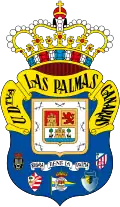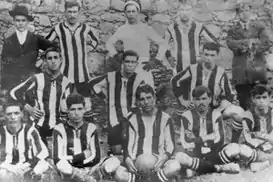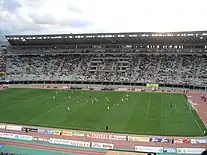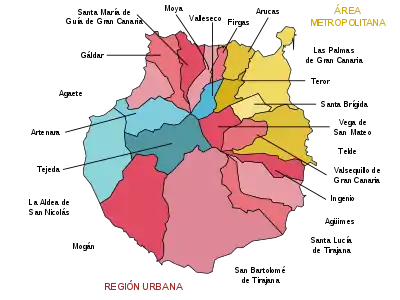 | ||||
| Full name | Unión Deportiva Las Palmas, S.A.D. | |||
|---|---|---|---|---|
| Nickname(s) | Los Amarillos La Unión Deportiva Pío Pío | |||
| Founded | 22 August 1949 | |||
| Ground | Estadio Gran Canaria | |||
| Capacity | 32,400[1] | |||
| President | Miguel Ángel Ramírez Alonso | |||
| Manager | García Pimienta | |||
| League | La Liga | |||
| 2022–23 | Segunda División, 2nd of 22 (promoted) | |||
| Website | Club website | |||
|
| ||||
Unión Deportiva Las Palmas,[2] commonly referred to as UD Las Palmas or Las Palmas, is a professional football club based in Las Palmas de Gran Canaria, Canary Islands, Spain. The club competes in La Liga, the top division in the Spanish football league system. Nicknamed Los Amarillos, the club was founded on 22 August 1949 as a result of a merger between five clubs in the Canary region. The club initially played in the Estadio Insular before hosting their home matches at the Estadio de Gran Canaria in 2003.
Las Palmas have been Segunda División champions four times, in 1953–54, 1963–64, 1984–85 and 1999–2000, and have won the Segunda División B twice, in 1992–93 and 1995–96. They have been runners-up in La Liga once, in 1968–69, and runners-up in the Copa del Rey, in 1977–78. Las Palmas is the only side in Spanish football to achieve back-to-back promotions to La Liga in their first two seasons. They had a 19-year run in the competition, ending in 1982–83 and has been promoted to La Liga on four additional occasions since that time, achieving it recently in 2022–23.
Since its foundation, the club has played with yellow and blue as their primary and secondary colours. They have a fierce rivalry with neighbouring island Tenerife, with whom they contest the Canary Islands derby. The two clubs are among the most isolated professional football clubs in Europe since they play their away games on the distant Spanish mainland.
History
Foundation and early years (1949–1954)


In the aftermath of the Spanish Civil War, which ended a decade earlier, football in the Canary Islands was facing numerous challenges. The war disrupted the organisation of championships and created financial difficulties for the local clubs. Despite the construction of the Las Palmas Stadium five years prior, the future of football in Gran Canaria was uncertain. Several prominent clubs, including Marino Fútbol Club, Real Club Victoria, Arenas Club, and Club Deportivo Gran Canaria, were struggling with financial issues. The geographical distance between the Canary Islands and the Spanish mainland made it economically impossible for these clubs to participate in national championships, which was essential for their growth and survival.[3][4]
Manuel Rodríguez Monroy, along with the support of Adolfo Miranda, the president of the Regional Football Federation, and other members of the board of directors, decided to propose a merger as a solution to the challenges facing the clubs.[5][6] Although some clubs initially had reservations, including Marino and Victoria due to their history and social following, Gran Canaria, Atlético, and Arenas quickly embraced the idea. The formal discussions began in a meeting held at the Regional Football Federation's headquarters in Las Palmas on 28 February 1949. During this meeting, the representatives of the clubs decided to form a work team known as the Fusion Report, which would meet regularly to advance the merger proposal.[3][4][5]
After more than a month of deliberations, Miranda and Monroy were tasked with presenting the proposal to the Royal Spanish Football Federation. On 4 April 1949, they submitted a letter requesting that the team resulting from the merger be included in the Second Division.[6] Initially, the request was rejected on the grounds that it could disadvantage other teams and alter promotion regulations. However, Ricardo Cabot, the secretary of the Royal Spanish Football Federation, promised to reconsider the proposal later. After a meeting in Madrid on 6 June 1949, Canary Islands football was accepted into the third division of Spanish football, with the components of Las Palmas starting in the competition the following season.[3][4]
The success of getting into national football led to the integration of Arenas and Gran Canaria under the name Unión Deportiva Las Palmas. This was the first phase of the merger, with the goal of eventually incorporating Atlético, Marino, and Victoria under the same banner. Despite progress, there were still disagreements among the clubs, including refusals to financially support the lease of the Las Palmas Stadium for UD Las Palmas to play its matches during the 1949–1950 season. In response to these challenges, Manuel Rodríguez Monroy organised a Magna Assembly on 22 August 1949, at the Real Club Náutico de Gran Canaria.[7] The assembly aimed to finalise the formation of Unión Deportiva Las Palmas. During this assembly, concerns were resolved and Unión Deportiva Las Palmas was officially established for the upcoming season.[3][4]
Las Palmas finished second in their first season in the Tercera División (1949–50), ranking third in the following year's Segunda División to reach La Liga for the first time ever, and became the first Spanish club to achieve consecutive promotions in its first two years of existence. The first season in the top flight ended, however, in relegation, but the team returned to the category in 1954, going on to enjoy a six-year spell.
Top-flight success
After Las Palmas returned to La Liga at the end of the 1963–64 season, again as champions, the club went on to have their most successful spell in the competition. Managed by Vicente Dauder, they finished third in 1967–68 behind Real Madrid and FC Barcelona, and four club players made the Spain squad which hosted and won the UEFA Euro 1964 tournament; the following season the team fared even better and only lost the league to Real Madrid, and thus qualified for European competition for the first time in its history, appearing in the 1969–70 Inter-Cities Fairs Cup and being knocked out in the first round by Germany's Hertha BSC (0–0 home draw, 0–1 away loss).

Las Palmas player Juan Guedes died suddenly on 9 March 1971 at the age of 28. The next season, French coach Pierre Sinibaldi led the club to the fifth place, with subsequent qualification for the UEFA Cup: after disposing of Torino F.C. and ŠK Slovan Bratislava, the Spaniards bowed out to Dutch club FC Twente; at the end of 1974–75 another team player, Tonono – a defender who played with Guedes – died of a liver infection.
Las Palmas' third appearance in European competition came with the 1977–78 UEFA Cup, where they defeated FK Sloboda Tuzla of Yugoslavia in the first round before falling to the English side Ipswich Town.[8] Under the management of Miguel Muñoz, and with players such as Argentines Miguel Ángel Brindisi, Daniel Carnevali (the first to arrive in 1973), Carlos Morete and Quique Wolff, the club also reached their first final of the Copa del Rey in that year, losing on 19 April to Barcelona at the Santiago Bernabéu Stadium (1–3).[9]
From the 1990s onwards, Las Palmas played mainly in the Segunda División, but also spent six years in Segunda División B – the new third level created in 1977 – and, from 2000 to 2002, competed in the top flight. On 3 October 2001 the side managed a 4–2 home win against Real Madrid, with youth product Rubén Castro scoring two goals for the hosts, but the season ended nonetheless in relegation.[10] On 22 December 2001, Las Palmas played its 1,000th game in La Liga. In the 2009–10 season in Segunda División the club finished 17th, just one point away from being relegated to Segunda División B. On 21 June 2015, Las Palmas was promoted back to La Liga after defeating Real Zaragoza on the away goals rule.
On 27 May 2023, Las Palmas achieved promotion to the first division by sealing a 2nd position in the table, respectively, on the very last match day of the season, after spending five years in the second tier.
Ciudad deportiva
The Ciudad Deportiva UD Las Palmas, also known as Barranco Seco, is the training ground of UD Las Palmas. Occupying a total area of 70,000 m², the complex is located in the area known as Barranco Seco at the southern outskirts of the city of Las Palmas.
History and construction
The current land in Barranco Seco was acquired by UD Las Palmas during the 1960s by the efforts of then club director Manuel Betancor. During the 1970s, there was only a single training pitch used by the reserve and junior teams of the club. In 1982, when the ground was upgraded to be used as a training field by the first team.
In June 2015, the Ciudad Deportiva project was initiated. However, works did not start until 2017. After around 2 years of construction works, the complex was finally opened on July 8, 2019. It was designed by architect Juan Palop-Casado,[11] who assured that the construction of this project was "an attempt that has been made to build with the greatest possible sustainability".[12] The construction was executed by "Construcciones Alex y Nadal, S.L.", involving around 380 workers, 10,000 tons of sand, nearly 300 tons of steel, almost 2,000 cubic meters of concrete and beams of approximately 1,600 meters.[13]
Being only the first phase of the entire sports city project, the club invested 22.5 million euros of its own funds to carry out the construction works of the current facilities.[14] The construction of a multifunctional service building is scheduled in the second phase. The eventual area of the complex will become 70,000 m² after the completion of the second phase.
Facilities
The new complex has modern changing rooms, a meeting hall, a gym with physiotherapy facilities, a dining room, a press room, in addition to two parking spaces designated for 130 vehicles. The Ciudad Deportiva is home to 3 regular size training pitches:[15]
- Ernesto Aparicio training field of natural grass.
- David García Santana training field of natural grass.
- Manuel Betancor training field of artificial turf, designated for the training sessions of UD Las Palmas Atlético and UD Las Palmas C; the reserve teams of the club.[16]
Seasons
Season to season


|
|
- 35 seasons in La Liga
- 33 seasons in Segunda División
- 6 seasons in Segunda División B
- 1 season in Tercera División
Recent seasons
| Season | Pos. | Pld | W | D | L | GF | GA | Pos. | Cup | Notesint | |
|---|---|---|---|---|---|---|---|---|---|---|---|
| 1999–2000 | 2D | 1 | 42 | 20 | 12 | 10 | 60 | 41 | 72 | Promoted | |
| 2000–01 | 1D | 11 | 38 | 13 | 7 | 18 | 42 | 62 | 46 | ||
| 2001–02 | 1D | 18 | 38 | 9 | 13 | 16 | 40 | 50 | 40 | Relegated | |
| 2002–03 | 2D | 5 | 42 | 16 | 16 | 10 | 53 | 43 | 64 | ||
| 2003–04 | 2D | 20 | 42 | 10 | 14 | 18 | 46 | 68 | 44 | Relegated | |
| 2004–05 | 2DB | 7 | 38 | 17 | 9 | 12 | 50 | 33 | 60 | ||
| 2005–06 | 2DB | 3 | 38 | 18 | 13 | 7 | 45 | 24 | 67 | Promoted | |
| 2006–07 | 2D | 18 | 42 | 13 | 12 | 17 | 51 | 59 | 51 | ||
| 2007–08 | 2D | 8 | 42 | 15 | 12 | 15 | 51 | 55 | 57 | ||
| 2008–09 | 2D | 18 | 42 | 10 | 17 | 15 | 46 | 51 | 47 | ||
| 2009–10 | 2D | 17 | 42 | 12 | 15 | 15 | 49 | 49 | 51 | ||
| 2010–11 | 2D | 15 | 42 | 13 | 15 | 14 | 56 | 71 | 54 | ||
| 2011–12 | 2D | 9 | 42 | 16 | 10 | 16 | 58 | 59 | 58 | ||
| 2012–13 | 2D | 6 | 42 | 18 | 12 | 12 | 62 | 55 | 66 | ||
| 2013–14 | 2D | 6 | 42 | 18 | 9 | 15 | 51 | 50 | 63 | ||
| 2014–15 | 2D | 4 | 42 | 22 | 12 | 8 | 73 | 47 | 78 | Promoted | |
| 2015–16 | 1D | 11 | 38 | 12 | 8 | 18 | 45 | 53 | 44 | ||
| 2016–17 | 1D | 14 | 38 | 10 | 9 | 19 | 53 | 74 | 39 | ||
| 2017–18 | 1D | 19 | 38 | 5 | 7 | 26 | 24 | 74 | 22 | Relegated | |
| 2018–19 | 2D | 12 | 42 | 12 | 18 | 12 | 48 | 50 | 54 |
European cup history
| Season | Competition | Round | Country | Club | Home | Away | Aggregate |
|---|---|---|---|---|---|---|---|
| 1969–70 | Inter-Cities Fairs Cup | Last 64 | Hertha BSC | 0–0 | 0–1 | 0–1 | |
| 1972–73 | UEFA Cup | Last 64 | Torino | 4–0 | 0–2 | 4–2 | |
| Last 32 | Slovan Bratislava | 2–2 | 1–0 | 3–2 | |||
| Last 16 | Twente | 2–1 | 0–3 | 2–4 | |||
| 1977–78 | UEFA Cup | Last 64 | Sloboda Tuzla | 5–0 | 3–4 | 8–4 | |
| Last 32 | Ipswich Town | 3–3 | 0–1 | 3–4 |
Current squad
- As of 31 August 2023.[17]
Note: Flags indicate national team as defined under FIFA eligibility rules. Players may hold more than one non-FIFA nationality.
|
|
Reserve team
Note: Flags indicate national team as defined under FIFA eligibility rules. Players may hold more than one non-FIFA nationality.
|
|
Out on loan
Note: Flags indicate national team as defined under FIFA eligibility rules. Players may hold more than one non-FIFA nationality.
|
|
Current technical staff
| Position | Staff |
|---|---|
| Manager | |
| Assistant manager | |
| Fitness coach | |
| Technical assistant | |
| Goalkeeping coach | |
| Delegate | |
| Match delegate | |
| Kit man | |
| Kitchen | |
| Doctor | |
| Chief physiotherapist | |
| Rehab fitness coach | |
| Physiotherapist |
Last updated: 21 September 2022
Source: [17]
Honours
- Runners-up (1): 1968–69
- Runners-up (1): 1978
Former players
List of coaches
 Satur Grech (1953–57)
Satur Grech (1953–57) Luis Molowny (1957–58)
Luis Molowny (1957–58) Baltasar Albéniz (1958–59)
Baltasar Albéniz (1958–59) Luis Molowny (1959)
Luis Molowny (1959) Marcel Domingo (1959–60)
Marcel Domingo (1959–60) Paco Campos (1961–62)
Paco Campos (1961–62) Rosendo Hernández (1962–63)
Rosendo Hernández (1962–63) Vicente Dauder (1963–66)
Vicente Dauder (1963–66) Luis Molowny (1968–70)
Luis Molowny (1968–70) Rosendo Hernández (1970)
Rosendo Hernández (1970) Héctor Rial (1970–71)
Héctor Rial (1970–71) Pierre Sinibaldi (1971–75)
Pierre Sinibaldi (1971–75) Heriberto Herrera (1975–76)
Heriberto Herrera (1975–76) Roque Olsen (1976–77)
Roque Olsen (1976–77) Miguel Muñoz (1977–79)
Miguel Muñoz (1977–79) Antonio Ruiz (1979–80)
Antonio Ruiz (1979–80) Heriberto Herrera (1982)
Heriberto Herrera (1982) Walter Skocik (1982–83)
Walter Skocik (1982–83) Héctor Núñez (1983–84)
Héctor Núñez (1983–84) Roque Olsen (1984–85)
Roque Olsen (1984–85) Ferenc Kovács (1986–87)
Ferenc Kovács (1986–87) Roque Olsen (1988)
Roque Olsen (1988) Paquito (1989–90)
Paquito (1989–90) Manolo Cardo (1990–91)
Manolo Cardo (1990–91) Roque Olsen (1991), (1991–92)
Roque Olsen (1991), (1991–92) Miguel Ángel Brindisi (1991–92)
Miguel Ángel Brindisi (1991–92) Iñaki Sáez (1993–94)
Iñaki Sáez (1993–94) Paco Castellano (1994–95)
Paco Castellano (1994–95) Iñaki Sáez (1995)
Iñaki Sáez (1995) Ángel Cappa (1996–97)
Ángel Cappa (1996–97) Paco Castellano (1997)
Paco Castellano (1997) Mariano García Remón (1997–98)
Mariano García Remón (1997–98) Paco Castellano (1998–99)
Paco Castellano (1998–99) Sergije Krešić (1999–01)
Sergije Krešić (1999–01) Fernando Vázquez (2001–02)
Fernando Vázquez (2001–02) Josu Uribe (2002–03)
Josu Uribe (2002–03) Juan Manuel Rodríguez (2003)
Juan Manuel Rodríguez (2003) David Vidal (2003–04)
David Vidal (2003–04) David Amaral (2004)
David Amaral (2004) Carlos Sánchez Aguiar (2004–05)
Carlos Sánchez Aguiar (2004–05) Josip Višnjić (2005–06)
Josip Višnjić (2005–06) Carlos Sánchez Aguiar (2006)
Carlos Sánchez Aguiar (2006) Juanito (2006–07)
Juanito (2006–07) Juan Manuel Rodríguez (2007–08)
Juan Manuel Rodríguez (2007–08) Javier Vidales (2008–09)
Javier Vidales (2008–09) Paco Castellano (2009)
Paco Castellano (2009) Sergije Krešić (2009–10)
Sergije Krešić (2009–10) Paco Jémez (2010–11)
Paco Jémez (2010–11) Juan Manuel Rodríguez (2011–12)
Juan Manuel Rodríguez (2011–12) Sergio Lobera (2012–14)
Sergio Lobera (2012–14) Josico (2014)
Josico (2014) Paco Herrera (2014–15)
Paco Herrera (2014–15) Quique Setién (2015–17)
Quique Setién (2015–17) Manolo Márquez (2017)
Manolo Márquez (2017) Pako Ayestarán (2017)
Pako Ayestarán (2017) Paco Jémez (2017–18)
Paco Jémez (2017–18) Manolo Jiménez (2018)
Manolo Jiménez (2018) Paco Herrera (2018–19)
Paco Herrera (2018–19) Pepe Mel (2019–22)
Pepe Mel (2019–22) García Pimienta (2022–)
García Pimienta (2022–)
Affiliated teams
Las Palmas has used farm teams since 1954, but its official B-team, Las Palmas Atlético, was founded in 1976.[18] A third side was founded in 2006 and reached the highest division of regional football, the Preferente, before folding in 2010 and being re-created the following season.[19]
The club also had a women's team in the top division between 2009 and 2011. In 2010 Las Palmas founded an indoor football team for the Liga de Fútbol Indoor, staging matches at the Centro Insular de Deportes.[20]
Crest
Las Palmas' badge is a blue shield with yellow scrolls on top with the club's name, city and archipelago. The municipal arms, granted by the city's mayor, feature in the centre of the design. Underneath lie the five crests of the clubs which united in 1949 to create the club: from left to right – Victoria, Arenas, Deportivo, Marino and Atlético; a smaller white scroll above them displays the city motto Segura tiene la palma.
In Spanish football, many clubs possess royal patronage and thus are permitted to use the prefix Real in their name and use an image of the Spanish crown. Las Palmas does not have such patronage, but tops its crest with the Spanish crown due to the patronage held by Real Club Victoria.
The crest is the central emblem of the club flag, a horizontal bicolour with yellow on top and blue underneath. The flag of the island of Gran Canaria uses these colours diagonally.
References
- ↑ "Gran Canaria Stadium". UD Las Palmas. Archived from the original on 14 October 2020. Retrieved 16 January 2020.
- ↑ Historia – Nombre del club (History – Club name) Archived 18 November 2012 at the Wayback Machine; Las Palmas' official website (in Spanish)
- 1 2 3 4 "22 de agosto de 1949, cuando nació el sentimiento amarillo". elDiario.es (in Spanish). Deportes Canarias Ahora. 22 August 2019. Archived from the original on 1 September 2023. Retrieved 1 September 2023.
- 1 2 3 4 "Historia de la UD Las Palmas". UD Las Palmas.net (in Spanish). 7 April 2009. Archived from the original on 1 September 2023. Retrieved 1 September 2023.
- 1 2 "La UD Las Palmas cumple 64 años de su fundación". UD Las Palmas (in Spanish). 22 August 2013. Archived from the original on 1 September 2023. Retrieved 1 September 2023.
- 1 2 "Historia". UD Las Palmas (in Spanish). Archived from the original on 1 September 2023. Retrieved 1 September 2023.
- ↑ "The UD Las palmas celebrates 66 anniversary returning back to the First National Division". UD Las Palmas. 22 August 2016. Archived from the original on 1 September 2023. Retrieved 1 September 2023.
- ↑ Historia – De las tragedias del destino a los argentinos (71–83) (Historia – From twists of fate to Argentines (71–83)) Archived 29 November 2010 at the Wayback Machine; Las Palmas' official website (in Spanish)
- ↑ Spain – Cup 1978 Archived 3 June 2023 at the Wayback Machine; at RSSSF
- ↑ Liga – El 'niño' que eclipsó a Zidane reta al Madrid (Liga – The 'boy' who eclipsed Zidane challenges Madrid) Archived 22 June 2015 at the Wayback Machine; Yahoo! Deportes, 12 October 2011 (in Spanish)
- ↑ "Inaugurada la Ciudad Deportiva UD Las Palmas". Archived from the original on 23 July 2021. Retrieved 23 July 2021.
- ↑ "Inaugurada la Ciudad Deportiva UD Las Palmas". Archived from the original on 23 May 2022. Retrieved 23 July 2021.
- ↑ "Un complejo deportivo de referencia arquitectónica". Archived from the original on 7 January 2022. Retrieved 23 July 2021.
- ↑ "UD Las Palmas Realidad Nueva Ciudad Deportiva". Archived from the original on 7 January 2022. Retrieved 23 July 2021.
- ↑ "Ciudad Deportiva Unión Deportiva Las Palmas" (PDF). Archived (PDF) from the original on 11 July 2019. Retrieved 23 July 2021.
- ↑ "¿Quieres ver cómo es la Ciudad Deportiva de la UD Las Palmas?". Archived from the original on 23 July 2021. Retrieved 23 July 2021.
- 1 2 "Plantilla" [Squad] (in Spanish). UD Las Palmas. Archived from the original on 21 March 2023. Retrieved 21 September 2022.
- ↑ El filial: vivero del fútbol canario (The farm team: feeding ground of Canarian football) Archived 14 July 2014 at the Wayback Machine; Historia del Fútbol Canario (in Spanish)
- ↑ La UD Las Palmas volverá a tener equipo "C" (UD Las Palmas to have a "C" team again) Archived 5 March 2012 at the Wayback Machine; Las Palmas' official website, 20 June 2011 (in Spanish)
- ↑ La UD Las Palmas crea un equipo de Fútbol Indoor (UD Las Palmas creates Indoor Football team) Archived 6 March 2012 at the Wayback Machine; Las Palmas' official website, 23 September 2010 (in Spanish)
External links
- Official website
- Futbolme team profile (in Spanish)
- BDFutbol team profile

